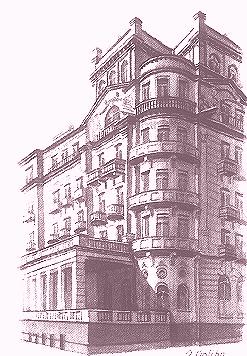 'Monster Cairo Hotel' announced
The Egyptian Gazette in its 16 March 1906 issue, referring to the near
completion of the new Semiramis Hotel situated in the genteel district of Kasr
al-Dubara.
'Monster Cairo Hotel' announced
The Egyptian Gazette in its 16 March 1906 issue, referring to the near
completion of the new Semiramis Hotel situated in the genteel district of Kasr
al-Dubara. |
|
|
|
|
Cheers to our "talented" literature prize awardee. Your pain his gain !!!
|
|
|
EGY.COM - GARDEN CITY
|
|
Samir Raafat
Cairo Times, November 13, 1997
 'Monster Cairo Hotel' announced
The Egyptian Gazette in its 16 March 1906 issue, referring to the near
completion of the new Semiramis Hotel situated in the genteel district of Kasr
al-Dubara.
'Monster Cairo Hotel' announced
The Egyptian Gazette in its 16 March 1906 issue, referring to the near
completion of the new Semiramis Hotel situated in the genteel district of Kasr
al-Dubara.
Except for the seasonal Gezira Palace Hotel situated on the Island of Gezirah (ex-Bulak Is.), the Semiramis was Cairo's first Nileside hotel. Hotels' Le Nationale, Grand Continental Savoy, Angleterre and the legendary Shepheards, all in the same elevated category, were either located off Opera Square or on the periphery of Ezbekieh Gardens.
The 'monster' was situated between the palaces of the Khediva Mother--Walda Pasha and that of her daughter Princess Nimet Kamal al-Dine (today Ministry of Foreign Affairs). Also nearby was the old palace of Kasr al-Nil turned into barracks for the British Army of Occupation (today Arab League and Nile Hilton Hotel).
The Semiramis was built on part of a 6,000 sq.m. plot owned by real estate baron Moise Cattaui Bey who sold it in February 1905 to Swiss hotelier Bucher-Durrer. Known for his Midas touch Bucher-Durrer in turn sold the property the following year for double the amount to the Société Suisse Eyptienne des Hotels en Egypte which he helped found.
The supervising architect of the six-story hotel was Italian engineer Tuilo Parvis. His cabinet on Madabegh (today Cherif) Street was among the most prominent in Cairo. The project contractor was the Belgian-run firm of Padova, Leon Rollin & Co., well known for their major undertakings across Egypt. Padova-Rollin promised to deliver the 200 room hotel to Bucher-Durrer on 1 January 1907.
True to their word, Padova, Rollin Co. delivered the Edwardian-styled hotel to Bucher-Durrer in time for a meticulously planned but short-lived dry run. Once the ornaments, mirrors, marble columns, Gobelin tapestries, Louis XVI salons, statues and furniture were in place, an official opening was announced for February 7.
The widely attended gathering brought together Cairo's leading officials and residents. On hand to greet the inaugural guests, were Mr. & Mrs. Theodore Bucher and Mr. Max Bucher. "Soon enough, manifestations of surprise and admiration were heard on every side as onlookers passed through the handsome apartments", reported The Egyptian Gazette the following day.
"To entertain gawking guests and amused aristocracy, an open buffet was laid out for the occasion in the Hotel's central halls as the 2nd. Battalion Royal Inniskilling Fusiliers band played familiar tunes. Later that evening, under the glowing cut glass chandeliers and electroliers, an orchestra directed by signor Bracale was succeeded by a sextet providing all night entertainment. The early-to-bed types, could, if they had to, settle in any one of the hotel suites or bedrooms. Except for the large brass bedsteads which were imported from England, the rooms were decorated in Empire style by Messrs. Keller & Co. of Zurich."
What was new and particular to this hotel characterized by its snow white facade was its roof garden, a first in flat arid Egypt. Some said it was inspired by the hanging gardens of Babylon where the Assyrian Queen Semiramis is said to have found undue pleasure.
Little did Bucher-Durrer realize that his florid undertaking and its roof garden would become an institution within the international café society, written up in countless interwar novels and biographies. From their elevated spot and as they sipped Lapsang Souchong tea in the finest china bone, or as they pranced to the sounds of the Big Bands, patrons of the Semiramis veranda or roof garden took in the Giza Pyramids and endless palm groves. In the daytime they watched as heavily laden fellucas sailed down the Nile. A similar vista was also available from any one of the hotel's many west-facing loggias and balconies.
In 1910 Bucher-Durrer sold his controlling shares in the Société Suisse Egyptienne des Hotels en Egypte to fellow Swiss Monsieur Charles Baehler who immediately entrusted his manager Mr. Wirth. Fifty additional rooms were added simutaneous to structural renovations.
In Egypt since October 1889, Baehler had worked for and then headed the Egyptian Hotels Company which owned and managed both the Gezirah Palace Hotel and the famed Shepheards. In 1906 he founded the Upper Egypt Hotels Company which operated amongst others the Cataract and Winter Palace hotels in Aswan and Luxor respectively. With the addition of the Semiramis to his set of trophies Charles Baehler and the Semiramis would become closely linked until he died in 1937.
The Semiramis and its legendary roof garden outlived Baehler by another 40 years. One of the hotel's last attention- getting event took place in February 1955 when the Aga Khan III was weighed for the last time in precious metal on the occasion of the 71th (platinum+1) year of his Imamate. He died the following year.
In the 1970s, Cairo's first all-year round Nileside hotel was pulled down to make way for the new Semiramis Intercontinental. At the writing of this article there is no hall, plaque, or restaurant commemorating the creator of the first Semiramis or the man who was once regarded the father of Egypt's hospitality industry.
(Note: The first Semiramis Hotel was inaugurated in 1907 and not ten years earlier as wrongly suggested by the management of the Semiramis Intercontinental.)
|
|
|
|